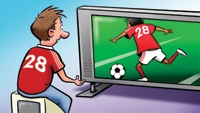Is the channel dead?
Last month I went to the Royal Television Society for the annual Schoenberg lecture, which commemorates one of the early developers of television. John Ive reviewed the development of television and offered a look into the future. One of his themes was that the spread of IP delivery and the use of store and forward would change the television landscape. As a result, channel scheduling could become an anachronism.
Because listings are circulated weeks in advance, why not store and forward during this time rather than occupy RF spectrum to broadcast the content? Of course, there are exceptions. For example, news, sports and special events must be broadcast live.
I got to thinking about this scenario. Where do we go? Will a program have a release date rather than a scheduled showing? What does that mean for the conventional channel? With store and forward, the important component is the content provider, not the delivery conduit. The increased usage of PVRs has freed viewers from following a schedule, and the electronic program guide (EPG) enables search by genre, but the channel still dominates the navigation.

A channel is an artificial construct stemming from the need to allocate spectrum for one-to-many broadcasting. If you move to IP distribution — to unicasting — the channel is no longer a necessity. Compare other sources of entertainment and information. In a bookstore, the shelves are split by subject for nonfiction, and by genre and author for fiction. Most people probably don't care who the publisher of a book is, and select a book by browsing and by author. Similarly, when in a movie rental store, most people search by star or director, but rarely care which studio made the movie.
Relating this to television, how do we select programs? We all have favorites that we watch every week. With hundreds of channels to choose from, only the lazy would stick to one channel. We usually discover new programs through a mix of channel promotions, personal recommendations, a TV guide and reviews. Or maybe we just explore the EPG. Take away the concept of a channel, and the promos are lost.
What of the business side? The channel and its schedules are at the core of our business. Moving to a store-and-forward model brings the content publishers and aggregators to the fore. Many publishers already run a series of channels, so these shifts need not be that disruptive. The focus shifts from channel branding to publisher branding.
Back to the Schoenberg lecture. Ive said he hoped that store-and-forward IP distribution would free up UHF spectrum for live HD channels. That way broadcast television could still be a premium source of entertainment with a picture quality to compete with digital cinema, game consoles and HD DVDs. This is a noble aim, but is there too much vested interest in the status quo of “the channel,” or will technology simply bypass our current distribution models? As PVRs become ubiquitous, VOD gains popularity, and increasing bandwidth is available to link homes to the content providers, there will be a migration from over-the-air viewing to the viewing of stored content, either network server-side or in the home.
Get the TV Tech Newsletter
The professional video industry's #1 source for news, trends and product and tech information. Sign up below.
Will television become niche entertainment for live events, with PCs, iPods, mobile phones and game consoles taking over for general visual entertainment? As the display and receiver functions separate, with products such as home networks, what is a television?
A footnote: In the Schoenberg lecture, Ive pointed out that the only technology to deliver entertainment that has survived since the development of television in the 1920s is cinema. Will HD prolong the life of the television receiver, or will the networked home take over?
Send comments to:editor@broadcastengineeringworld.com
